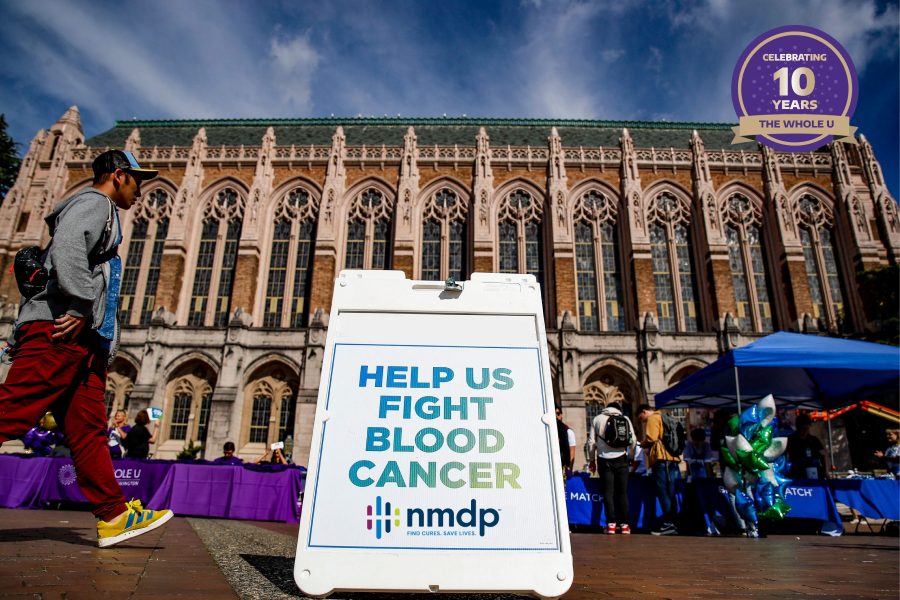
Get in the Game — support the life-saving work of NMDP
The University of Washington is proud to partner with the National Marrow Donor Program (NMDP), formally known as Be The Match. NMDP is a renowned education, research and advocacy organization that oversees the world’s largest marrow registry.
This partnership plays a crucial role in linking individuals battling life-threatening blood diseases and cancers with potential life-saving donors. Learn more about this partnership.
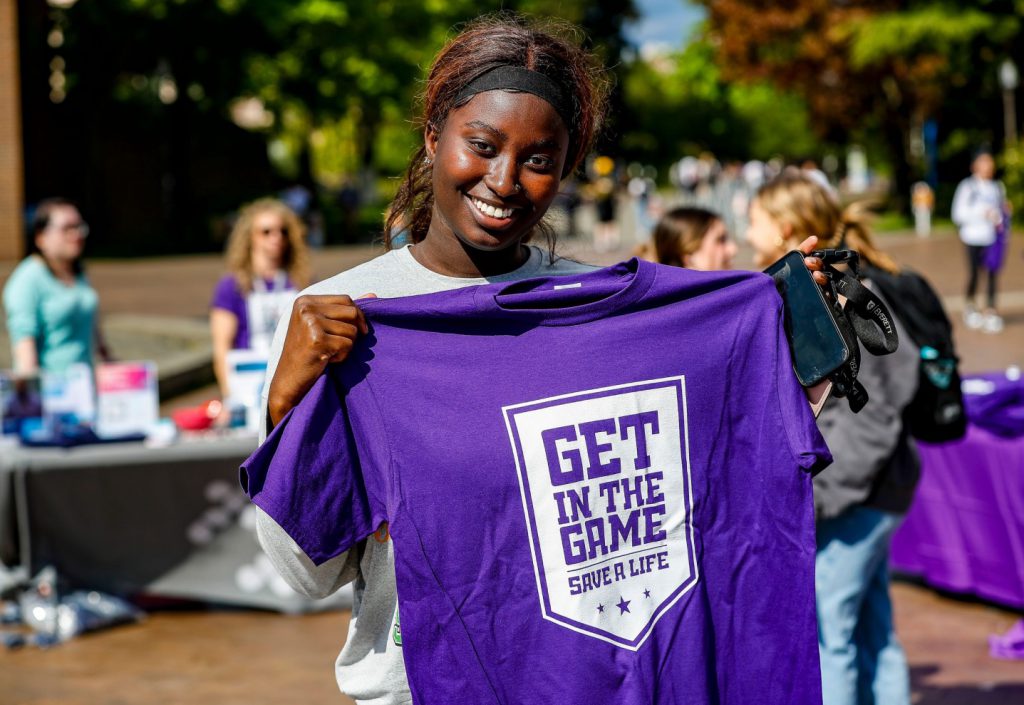 Get in The Game
Get in The Game
On Thursday, May 2, from 11:00 a.m. to 3:00 p.m., The Whole U, NMDP and UW Athletics invite you to join us in Red Square to learn more about the UW’s partnership with NMDP and how you can join the life-saving registry.
Discover more about NMDP, receive a complimentary T-shirt, get a photo with Harry Husky and meet UW coaches and athletes!
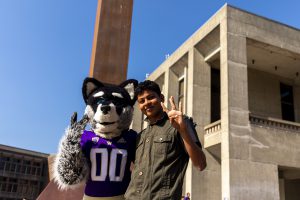 To date, more than 500 UW students, faculty and staff have registered for Be The Match and requested their swab kits in the mail. This is an amazing response. Thank you to everyone who has already become a donor. But we’re just getting started!
To date, more than 500 UW students, faculty and staff have registered for Be The Match and requested their swab kits in the mail. This is an amazing response. Thank you to everyone who has already become a donor. But we’re just getting started!
Why joining the registry matters
Finding a 100% donor match is crucial to positive outcomes post-transplant. But the chance of finding a perfect match is lower for certain demographic groups because people of color and mixed-race donors are underrepresented in the registry. While white people have a 75% chance of finding a full match in the existing marrow registry, people with African and African American ancestry only have a 19% likelihood of finding a match and comprise only 7% of the United States registry.
People of color, particularly those with mixed-raced ancestries, are encouraged to consider becoming potential donors. Growing and diversifying the registry’s pool of potential donors increases peoples’ chances of finding a match and treating their blood disorders.
“I work with NMDP in the name of people who did not find a match and were not able to live. The NMDP bone marrow registry literally cures cancer. While we can’t cure all cancers, stem cell transplants can cure over 70 blood disorders, including the type of leukemia that I was diagnosed with 7 years ago.” – UW Regent Alexes Harris
Alexes Harris’s passion project
The inspiration for the annual “Get in the Game” registry event came from Alexes Harris, a professor of sociology and UW Regent.
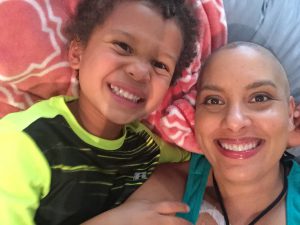 In May of 2016, Dr. Harris was diagnosed with myelodysplastic syndrome, a rare blood cancer and form of leukemia. She immediately committed to fighting with everything she had — for her and for her family.
In May of 2016, Dr. Harris was diagnosed with myelodysplastic syndrome, a rare blood cancer and form of leukemia. She immediately committed to fighting with everything she had — for her and for her family.
Her battle began with inpatient chemotherapy. After a week of intense treatment, her cancer went into remission. However, the aggressive nature of her cancer demanded that she get a stem cell transplant from a matching healthy donor.
Her mixed-race heritage meant long odds of finding a donor match on the registry.
Her twin brother did not turn out to be a match. Two potential matching donors declined to move forward. Ultimately, the only viable match for Dr. Harris turned out to be her 20-year-old self (she had signed up for the registry when she was an undergraduate at the UW) —a solution that obviously couldn’t work. “I just needed someone to save my life,” she recalled, “but I couldn’t find anyone on the donor registry.”
Unable to locate a match and running out of time, Dr. Harris decided to receive a mismatched transplant, which typically extends the life of a person in her condition by maybe two years. This seemed like the only option.
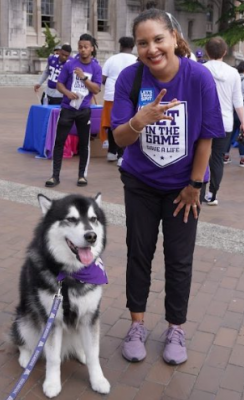 …Until she learned of a clinical trial at Fred Hutch Cancer Center (formerly Seattle Cancer Care Alliance) using umbilical cord blood for her transplant. She enrolled in the trial, which finally resulted in a more sustainable remission.
…Until she learned of a clinical trial at Fred Hutch Cancer Center (formerly Seattle Cancer Care Alliance) using umbilical cord blood for her transplant. She enrolled in the trial, which finally resulted in a more sustainable remission.
Dr. Harris remains healthy seven years later. She has spent those precious seven years raising her children, researching racial inequities, teaching, mentoring, advocating, leading.
And throwing her influence and energies into a cause that has become her passion. She leveraged her position as the UW faculty athletics representative to launch Get in the Game at the UW. “I am one of the few people who didn’t find a match but got to live,” she says. “So, I need to be an advocate for people to get on the registry.”
Dr. Harris is determined to raise awareness and educate people on how joining the registry can save lives. “The people who passed due to not finding a match—I will never forget them and the amazing life that they could have had if they had more time. So, for me, that is what the registry is about: getting people more time.”
“It brings me so much joy,” she adds, “to see students out there and recognize that they have the power to fight cancer.”
Watch: Alexes Harris calls for more people of color in the bone marrow registry
Listen: “A Mother’s Day Appeal” from cord blood recipient Alexes Harris
Conception of Get in The Game
Although the official NMDP and UW partnership is the first of its kind, Get in the Game isn’t a new concept. It was created in 2008 by Andy Tally, the former head football coach at Villanova, and Be The Match (now NMDP). Today, Get in the Game is a nationwide series of events hosted by 80 college football programs.
The mission is always the same: spread the word about NMDP and show students the need and the impact they can make by joining the registry.
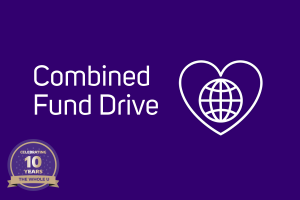
Support NMDP through the UW Combined Fund Drive
Consider making a one-time, monthly, bi-monthly, or annual monetary contribution to NMDP through the UW Combined Fund Drive. Your donations can be deducted from your paycheck to make contributions simple.
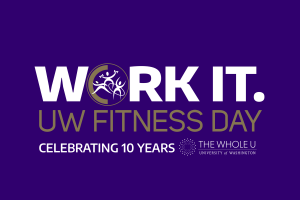
Support NMDP by attending UW Fitness Day on May 8
Get in the Game is not the only upcoming campus event supporting the work of NMDP. UW Fitness Day, a campus-wide workout in Husky Stadium at lunchtime on May 8, will raise vital funds to benefit NMDP. Register today to participate in UW Fitness Day.